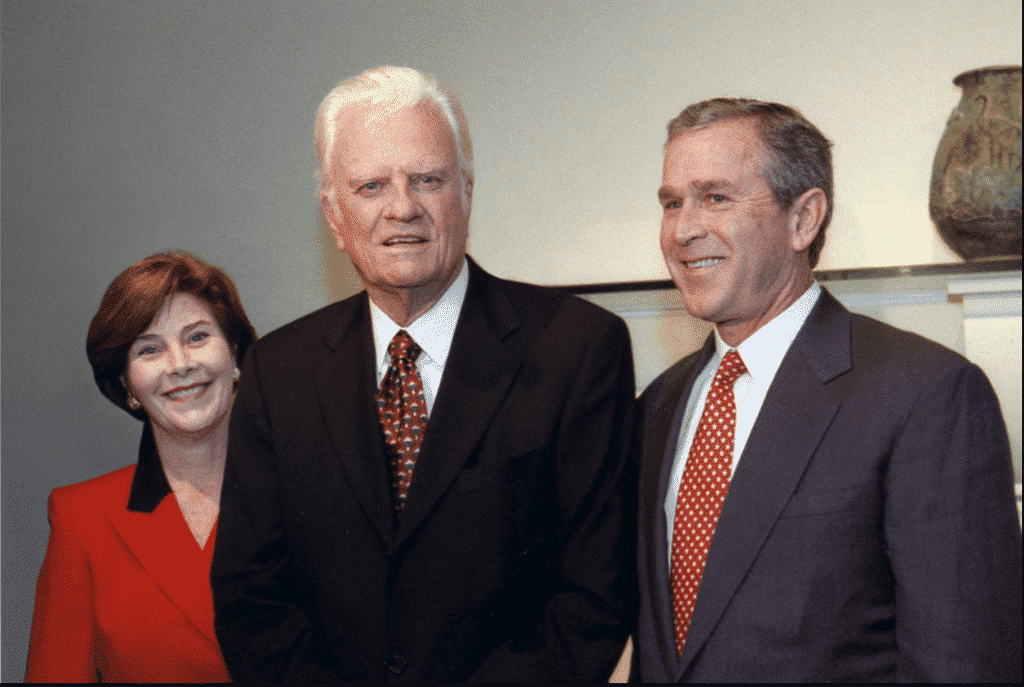A lot has been written about Billy Graham’s legacy. Known for his combination of wit and wisdom, Billy Graham has been one of the most influential spiritual voices across the globe for decades reaching over 200 million people in more than 185 countries.
(Born November 7, 1918) Billy Graham is now 99 years of age, and while he is doing well, he does have the physical challenges that come with age.
He said;
“Over the years, I’ve had a number of illnesses and surgeries ”¦ Often they came just as we were about to embark on a Crusade or other project, and I could not help but wonder whether Satan was using them to attack our work in some way (and I suspect that was true). At the same time, though, God used them to teach me patience and to give me time that I might otherwise not have taken to read and contemplate.”
It’s a good thing for the modern Church that Billy Graham was determined in his course as the truth he has preached for years still transcends all barriers of denominational differences, age, nationality, and culture, pointing millions to Christ.
Here are a few of his most memorable quotes:
- “I feel sorry for the man who has never known the bracing thrill of taking a stand and sticking to it fearlessly. Moral courage has rewards that timidity can never imagine. Like a shot of adrenaline, it floods the spirit with vitality” ’- Billy Graham
- “Self-centered indulgence, pride and a lack of shame over sin are now emblems of the American lifestyle.” ’- Billy Graham
- “I’ve read the last page of the Bible, it’s all going to turn out all right.”’- Billy Graham
- “When we come to the end of ourselves, we come to the beginning of God.”’- Billy Graham
- “Jesus was not a white man; He was not a black man. He came from that part of the world that touches Africa and Asia and Europe. Christianity is not a white man’s religion and don’t let anybody ever tell you that it’s white or black. Christ belongs to all people; He belongs to the whole world”’- Billy Graham
- “Our society strives to avoid any possibility of offending anyone – except God.”’- Billy Graham
- “The will of God will not take us where the grace of God cannot sustain us.”’- Billy Graham
- “The cross shows us the seriousness of our sin—but it also shows us the immeasurable love of God.”’- Billy Graham
- “It is the Holy Spirit’s job to convict, God’s job to judge and my job to love.”’- Billy Graham
- “Without the resurrection, the cross is meaningless.”’- Billy Graham
- “Believers, look up – take courage. The angels are nearer than you think.”’- Billy Graham
- “Quit beating yourself up. We all live under grace and do the best we can.”’- Billy Graham
- “God never takes away something from your life without replacing it with something better.”’- Billy Graham
- “If you know Christ, you don’t need to beg for the Holy Spirit to come into your life; He is already there— whether you “feel” His presence or not. Don’t confuse the Holy Spirit with an emotional feeling or a particular type of spiritual experience.”’- Billy Graham
- “We say to our children, ‘Act like grown-ups,’ but Jesus said to the grown-ups, ‘Be like children.”’- Billy Graham
- “Comfort and prosperity have never enriched the world as much as adversity has.”’- Billy Graham
- “Sin is the second most powerful force in the universe, for it sent Jesus to the cross. Only one force is greater—the love of God.”’- Billy Graham
- “Knowing we will be with Christ forever far outweighs our burdens today! Keep your eyes on eternity!”’- Billy Graham
-
“The will of God will not take us where the grace of God cannot sustain us.”’- Billy Graham
-
“Courage is contagious. When a brave man takes a stand, the spines of others are stiffened.”’- Billy Graham
-
“We are the Bibles the world is reading; We are the creeds the world is needing; We are the sermons the world is heeding.”’- Billy Graham
-
The test of a preacher is that his congregation goes away saying, not, `What a lovely sermon!` but `I will do something.”’- Billy Graham
-
“Millions of angels are at God’s command. “’- Billy Graham
- “World events are moving very rapidly now. I pick up the Bible in one hand, and I pick up the newspaper in the other. And I read almost the same words in the newspaper as I read in the Bible. It’s being fulfilled every day round about us.”’- Billy Graham
- “My home is in Heaven. I’m just traveling through this world.”’- Billy Graham
- “God proved his love on the Cross. When Christ hung, and bled, and died, it was God saying to the world, ‘I love you.”’- Billy Graham
- “Suppose you could gain everything in the whole world and lost your soul. Was it worth it?”
- “There is nothing wrong with men possessing riches. The wrong comes when riches possess men.”’- Billy Graham
- “The only time my prayers are never answered is on the golf course.”’- Billy Graham
- “A real Christian is the one who can give his pet parrot to the town gossip.”’- Billy Graham
- “I have never known anyone to accept Christ’s redemption and later regret it.”’- Billy Graham
- “When wealth is lost, nothing is lost; when health is lost, something is lost; when character is lost, all is lost.”’- Billy Graham
- “God has given us two hands, one to receive with and the other to give with.”’- Billy Graham
- “Being a Christian is more than just an instantaneous conversion – it is a daily process whereby you grow to be more and more like Christ.”’- Billy Graham
- “Joy cannot be pursued. It comes from within. It is a state of being. It does not depend on circumstances, but triumphs over circumstances. It produces a gentleness of spirit and a magnetic personality.”’- Billy Graham
- “Reading God’s Word and meditating on its truth will have a purifying effect upon your mind and heart, and will be demonstrated in your life. Let nothing take the place of this daily privilege.”’- Billy Graham
- “The Christian life is not a constant high. I have my moments of deep discouragement. I have to go to God in prayer with tears in my eyes, and say, ‘O God, forgive me,’ or ‘Help me.”’- Billy Graham
- “Tears shed for self are tears of weakness, but tears shed for others are a sign of strength.”’- Billy Graham
- “The framers of our Constitution meant we were to have freedom of religion, not freedom from religion.”’- Billy Graham
- “Mountaintops are for views and inspiration, but fruit is grown in the valleys.”’- Billy Graham
- “The message I preach hasn’t changed. Circumstances have changed. Problems have changed, but deep inside man has not changed, and the gospel hasn’t changed.”’- Billy Graham
- “The only hope for enduring peace is Jesus Christ.”’- Billy Graham
- “The moment we take our last breath on earth, we take our first in heaven.”’- Billy Graham
- “Someone asked me recently if I didn’t think God was unfair, allowing me to have Parkinson’s and other medical problems when I have tried to serve him faithfully. I replied that I did not see it that way at all. Suffering is part of the human condition, and it comes to us all. The key is how we react to it, either turning away from God in anger and bitterness or growing closer to him in trust and confidence.”’- Billy Graham
The following is a photograph of Graham with each president.
#1. HARRY TRUMAN (1884–1972) | DEMOCRAT | 1945–1953

Graham later met Truman in 1967:

#2. DWIGHT EISENHOWER (1890–1969) | REPUBLICAN | 1953–1961

#3. JOHN F. KENNEDY (1917–1963) | DEMOCRAT | 1961–1963

#4. LYNDON JOHNSON (1908–1973) | DEMOCRAT | 1963–1969

#5. RICHARD NIXON (1913–1994) | REPUBLICAN | 1969–1974

#6. GERALD FORD (1913–2006) | REPUBLICAN | 1974–1977

#7. JIMMY CARTER (1924– ) | DEMOCRAT | 1977–1981

#8. RONALD REAGAN (1911–2004) | REPUBLICAN | 1981–1989

#9. GEORGE H. W. BUSH (1924– ) | REPUBLICAN | 1989–1993

#10. BILL CLINTON (1946– ) | DEMOCRAT | 1993–2001

#11. GEORGE W. BUSH (1946– ) | REPUBLICAN | 2001–2009

#12. BARACK OBAMA (1961– ) | DEMOCRAT | 2009–2017

#13. DONALD TRUMP (1946– ) | REPUBLICAN | 2017–




























PHOTOGRAPH BY LUCA LOCATELLI, INSTITUTE
Throughout the city, there are many green buildings such as the CapitaGreen office tower, the Park Royal on Pickering hotel and the Tree House condo near Bukit Timah Nature Reserve.
The futuristic ‘Gardens by the Bay’ in central Singapore, is a revolutionary botanical garden spanning over 100 hectares of reclaimed land. It’s a beautiful asset to the city but may also offer a path to the health and happiness of its citizens.
Transport is another sector that has seen investment recently. On an island of 4.8 million people with limited space. After a series of smart card innovations, people have been able to use e-Symphony, an IBM-designed payment card that can be used to pay for road tolls, bus travel, taxis, the metro, and even shopping.